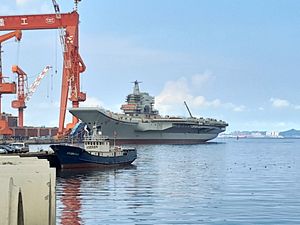China’s first domestically designed and built aircraft carrier, the Type 001A Shandong (CV-17), could take to the sea for the first time this month as final preparations for the ship’s sea trials are underway at the at the Dalian Shipbuilding Industry Company (DSIC) shipyard in Liaoning Province.
“All the equipment and devices on the carrier are in the joint debugging stage, and the main engine has been powered. In 2018, we will present a surprise to the Chinese people,” DSIC Chairman Liu Zheng was quoted as saying by Chinese state-owned media in late March. In conjunction with the statement, DSIC released pictures showing all scaffolds on the carrier removed indicating that exterior installation work on the ship has been completed.
There is speculation that the carrier could take to the sea around Navy Day, the founding day of the People’s Liberation Army Navy (PLAN), on April 23, however, no date for the ship’s maiden voyage has been officially set. As I reported in January, there was some speculation that the Shandong’s first set of sea trials could take place in mid-February around the annual Spring Festival or Chinese New Year.
The 65,ooo-ton Type 001A carrier was launched at the DSIC shipyard in April 2017. The warship is an improved variant of the PLAN’s only operational aircraft carrier, the 60,000-ton Type 001 Liaoning — a retrofitted Soviet-era Admiral Kuznetsov-class multi-role aircraft carrier. (The Liaoning and its escort ships entered Taiwan’s air defense identification zone last month during a naval training exercise.)
The Shandong has been fitted with a so-called ski-jump assisted Short Take-Off But Arrested Recovery (STOBAR) launch system also installed aboard the Liaoning. STOBAR-launched aircraft have a more limited operational range and carry lighter payloads than fighter jets launched from so-called Catapult-Assisted Take-Off But Arrested Recovery (CATOBAR) systems used on U.S. Navy carriers. (STOBAR systems put a lot of strain on the airframe of fighter jets during take-off.)
The Shandong will be able to carry up to 24 Shenyang J-15 multirole fighter jets, a variant of the fourth-generation Sukhoi Su-33 twin-engines air superiority fighter, as well as around ten rotary wing aircraft including Changshe Z-18, Ka-31, or Harbin Z-9 helicopters.
Trials of the new carrier, slated to take place in the Bohei Sea, will take around six to 12 months, after which the warship will be commissioned into service. The Shandong is expected to serve in the PLAN’s North Sea Fleet or East Sea Fleet and unlike the Liaoning, which primarily serves as a test platform for PLAN naval aviation, will be deployed for regular carrier strike group operations.

































